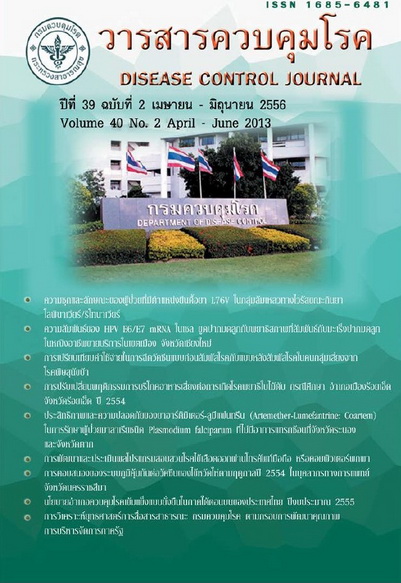Immunogenicity of 2011 Trivalent Influenza Vaccine among Healthcare Workers in Nakhon Ratchasima
DOI:
https://doi.org/10.14456/dcj.2013.36Keywords:
2011 trivalent influenza vaccine, immunogenicity, healthcare workers, Nakhon RatchasimaAbstract
In Thailand, influenza vaccination program was launched in 2004. During 2004-2007, the influenza vaccine was recommended for only healthcare workers (HCWs) and gradually expanded to include other subpopulation groups in 2008. Although the healthcare workers acquire an annual vaccination, outbreaks of influenza among healthcare workers had been reported frequently. This study was conducted to determine influenza seroconversion rate and protective level of immunity of the 2011 trivalent influenza vaccine. This was a cross-sectional conducted to determine immunogenicity. We collected serum samples from vaccines for Haemagglutination inhibition (HI) test both before and 30 days after vaccination. Geometric mean titer, influenza seroconversion rate and protective level of immunity were estimated. It was found that among 98 healthcare workers enrolled in immunogenicity study, highest antibody geometric means titer was in A/Perth/16/2009/H3N2 (52.3), followed by B/Brisbane/60/2008 (38.2) and A/California/7/2009/H1N1 (35.4). The high percentages of influenza seroconversion were observed in A/Perth/16/2009/H3N2 (37.7%), A/California/7/2009/H1N1 (35.7%) and B/Brisbane/60/2008 (15.3%). The percentage of vaccines who reached protective level of immunity after receiving vaccine was highest in A/Perth/16/2009/H3N2 (70.4%), followed by B/Brisbane/60/2008 (66.3%) and A/California/7/2009/H1N1 (57.1%). In conclusions, antibody geometric mean titer and influenza seroconversion after receiving 2011 trivalent influenza vaccine was highest in A/Perth/16/2009/H3N2. The vaccine raised herd immunity level in all subtypes of influenza virus to over 50%.
Downloads
References
2. เอมอร ราษฏจำเริญสุข. การบริหารจัดการวัคซีนและระบบลูกโซ่ความเย็น, ใน: พรศักดิ์ อยู่เจริญ, บรรณาธิการ. การสร้างเสริมภูมิคุ้มกันโรคสำหรับเจ้าหน้าสาธารณสุข 2547. กรุงเทพมหานคร: โรงพิมพ์องค์การสงเคราะห์ทหารผ่านศึก; 2547 หน้า 96-99.
3. สำนักระบาดวิทยา สำนักงานปลัดกระทรวงสาธารณสุข. คู่มือการดำเนินงานโครงการวัคซีนไข้หวัดใหญ่ พิมพ์ครั้งที่ 1. กรุงเทพมหานคร: โรงพิมพ์องค์การรับส่งสินค้าและพัสดุภัณฑ์ (ร.ส.พ); 2554.
4. Centers for Disease Control and Prevention (CDC). Serum cross-reactive antibody response to a novel influenza A (H1N1) virus after vaccination with seasonal influenza vaccine. MMWR Morb Mortal Wkly Rep 2009; 58(19):521-524
5. Palache AM, Beyer WE, Sprenger MJ et al. Antibody response after influenza immunization with various vaccine doses: a double-blind, placebo-controlled, multi-centre, dose-response study in elderly nursing-home residents and young volunteers. Vaccine 1993; 11(1):3-9.
6. Update on influenza A (H1N1) 2009 monovalent vaccines. MMWR Morb Mortal Wkly Rep. 2009;1101-58:1100
7. World Health Organization. http://www.carec.org/influenzaa-H1N1-pandemic-declaration.html.2009.
Downloads
Published
How to Cite
Issue
Section
License
Articles published in the Disease Control Journal are considered as academic work, research or analysis of the personal opinion of the authors, not the opinion of the Thailand Department of Disease Control or editorial team. The authors must be responsible for their articles.






